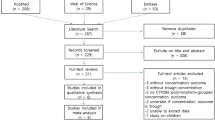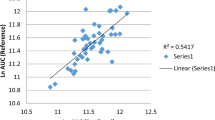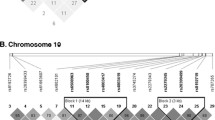Abstract
Purpose
Differences in drug metabolism due to cytochrome P450 (CYP) polymorphisms may be significant enough to warrant different dosing strategies in carriers of specific cytochrome P450 (CYP) polymorphisms, especially for drugs with a narrow therapeutic index. The impact of such polymorphisms on drug plasma concentrations and the resulting dosing strategies are presented in this review, using the example of efavirenz (EFV).
Methods
A structured literature search was performed to extract information pertaining to EFV metabolism and the influence of polymorphisms of CYP2B6, ethnicity, sex and drug interactions on plasma concentrations of EFV. The corresponding dosing strategies developed for carriers of specific CYP2B6 genotypes were also reviewed.
Results
The polymorphic CYP2B6 enzyme, which is the major enzyme in the EFV
metabolic pathway, is a key determinant for the significant inter-individual differences seen in EFV pharmacokinetics and pharmacodynamics (PKPD). Ethnic differences and the associated prevalence of CYP2B6 polymorphisms result in significant differences in the PKPD associated with a standard 600 mg per day dose of EFV, warranting dosage reduction in carriers of specific CYP2B6 polymorphisms. Drug interactions and auto-induction also influence EFV PKPD significantly.
Conclusion
Using EFV as an example of a drug with a narrow therapeutic index and a high inter-patient variability in plasma concentrations corresponding to a standard dose of the drug, this review demonstrates how genotyping of the primary metabolising enzyme can be useful for appropriate dosage adjustments in individuals. However, other variables such as drug interactions and auto-induction may necessitate plasma concentration measurements as well, prior to personalising the dose.

Similar content being viewed by others
References
Zanger UM, Klein M (2013) Pharmacogenetics of cytochrome P450 2B6 (CYP2B6): advances on polymorphisms, mechanisms, and clinical relevance. Front Genet 4: 24 Published online 2013 March 5. doi: 10.3389/fgene.2013.00024 DOI:10.3389%2Ffgene.2013.00024#pmc_ext
Bradford LD (2002) CYP2D6 allele frequency in European Caucasians, Asians, Africans and their descendants. Pharmacogenomics 3:229–243
Zhou SF, Liu JP, Chowbay B (2009) Polymorphism of human cytochrome P450 enzymes and its clinical impact. Drug Metab Rev 41:89–295
Li J, Bluth MH (2011) Pharmacogenomics of drug metabolizing enzymes and transporters: implications for cancer therapy. Pharmacogenomics Personalized Med 4:11–33
Alessandrini M, Asfaha S, Dodgen TM, Warnich L, Pepper M (2013) Cytochrome P450 pharmacogenetics in African populations. Drug Metab Rev 45:253–275
Frueh FW, Amur S, Mummaneni P et al (2008) Pharmacogenomic biomarker information in drug labels approved by the United States food and drug administration: prevalence of related drug use. Pharmacotherapy 28:992–998
Soldin OP, Mattison DR (2009) Sex differences in pharmacokinetics and pharmacodynamics. Clin Pharmacokinet 48(3):143–157
Chetty M, Mattison DR, Rostami-Hodjegan A (2012) Sex differences in the clearance of CYP3A4 substrates: exploring possible reasons for the substrate dependency and lack of consensus. Curr Drug Metab 13:778–786
Young SD, Britcher SF, Tran LO et al (1995) L-743,726(DMP-266): a novel, highly potent non-nucleoside inhibitor of the human immunodeficiency virus type 1 reverse transcriptase. Antimicrob Agents Chemother 39(12):2602–2605
Haas D, Hicks C, Seekins D et al. (1998) A phase II, double-blind placebo-controlled, dose-ranging study to assess the antiretroviral activity and safety of Efavirenz (DMP-266) in combination with open-label zidovudine (ZDV) with Lamivudine (3TC) at 24 weeks (DMP 266–005). 5th Conference on Retroviruses and Opportunistic Infections Chicago ((Abstract) 698)
Riddler S, Kahn J, Hicks C et al. (1998) Durable clinical anti-HIV-1 activity (72 weeks) and tolerability for Efavirenz (DMP 266) in combination with Indinavir (IDV) [DMP266–003, Cohort IV]. 12th World AIDS Conference Geneva June 28-July 3 1998 (abstract 12359).
Vrouenraets SME, Wit FWNW, Van Tongeren J, Lange JMA (2007) Efavirenz: a review. Expert Opin Pharmacother 8(6):851–871
Marzolini C, Telenti A, Decosterd LA, Greub G, Biollaz J, Buclin T (2001) Efavirenz plasma levels can predict treatment failure and central nervous system side effects in HIV-1-infected patients. AIDS 15:71–75
Núñez M, González de Requena D, Gallego L, Jiménez-Nácher I, González-Lahoz J, Soriano V (2001) Higher efavirenz plasma levels correlate with development of insomnia. J Acquir Immune Defic Syndr 28:399–400
Csajka C et al (2003) Population pharmacokinetics and effects of efavirenz in patients with human immunodeficiency virus infection. Clin Pharmacol Ther 73:20–30
Gutiérrez F et al (2005) Prediction of neuropsychiatric adverse events associated with long-term efavirenz therapy, using plasma drug level monitoring. Clin Infect Dis 41:1648–1653
van Luin M et al (2009) Efavirenz dose reduction is safe in patients with high plasma concentrations and may prevent efavirenz discontinuations. J Acquir Immune Defic Syndr 52:240–245
Gazzard BG (1999) Efavirenz in the management of HIV infection. Int J Clin Pract 53:60–64
Arab-Alameddine M et al (2009) Pharmacogenetics-based population pharmacokinetic analysis of efavirenz in HIV-1-infected individuals. Clin Pharmacol Ther 85:485–494
Sánchez A, Cabrera S, Santos D, Paz Valverde M, Fuertes A, Domínguez-Gil A et al (2011) Population pharmacokinetic/pharmacogenetic model for optimization of Efavirenz therapy in Caucasian HIV-infected patients. Antimicrob Agents Chemother 55(11):5314
Bacheler LT, Anton ED, Kudish P et al (2000) Human immunodeficiency virus type 1 mutations selected in patients failing efavirenz combination therapy. Antimicrob Agents Chemother 44(9):2475–2484
Deeks SG (2001) International perspectives on antiretroviral resistance. Nonnucleoside reverse transcriptase inhibitor resistance. J Acquir Immune Defic Syndr 26(suppl 1):S25–S33
Smith PF, DiCenzo R, Morse GD (2001) Clinical pharmacokinetics of Non-nucleoside reverse transcriptase inhibitors. Clin Pharmacokinet 40(12):893–905
Tashima KT, Caliendo AM, Ahmad M et al (1999) Cerebrospinal fluid human immunodeficiency virus type 1 (HIV-1) suppression and efavirenz drug concentrations in HIV-1-infected patients receiving combination therapy. J Infect Dis 180:862–4
Reddy YS, Gotzkowsky SK, Eron JJ et al (2002) Pharmacokinetic and pharmacodynamic investigation of efavirenz in the semen and blood of human immunodeficiency virus type 1-infected men. J Infect Dis 186(9):1339–1343
Ghosn J, Chaix ML, Peytavin G et al (2004) Penetration of enfuvirtide, tenofovir, efavirenz and protease inhibitors in the genital tract of HIV-1-infected men. AIDS 18(14):1958–1961
Villani P, Regazzi MB, Castelli F, Viale P, Torti C, Seminari E, Maserati R Pharmacokinetics of efavirenz (EFV) alone and in combination therapy with nelfinavir (NFV) in HIV-1 infected patients. Br J Clin Pharmacol 48:712–715
Ward BA et al (2003) The cytochrome P450 2B6 (CYP2B6) is the main catalyst of efavirenz primary and secondary metabolism: implication for HIV/AIDS therapy and utility of efavirenz as a substrate marker of CYP2B6 catalytic activity. J Pharmacol Exp Ther 306:287–300
Cho DY, Ogburn ET, Jones D, Desta Z (2011) Contribution of N-glucuronidation to Efavirenz elimination in vivo in the basal and rifampin-induced metabolism of Efavirenz. Antimicrob Agents Ch 55:1504–1509
Desta Z, Saussele T, Ward B et al (2007) Impact of CYP2B6 polymorphism on hepatic efavirenz metabolism in vitro. Pharmacogenomics 8:547–558
Mouly S, Lown KS, Kornhauser D et al (2002) Hepatic but not intestinal CYP3A4 displays dose-dependent induction by efavirenz in humans. Clin Pharmacol Ther 72:1–9
Mutlib AE et al (1999) Identification and characterization of efavirenz metabolites by liquid chromatography/mass spectrometry and high field NMR: species differences in the metabolism of efavirenz. Drug Metab Dispos 27:1319–133
Faucette SR, Zhang TC, Moore R, Sueyoshi T et al (2007) Relative activation of human pregnane X receptor versus constitutive androstane receptor defines distinct classes of CYP2B6 and CYP3A4 inducers. J Pharm Exp Ther 320:72–80
Ngaimisi E, Mugusi S, Minzi OM et al (2010) Long-term Efavirenz auto-induction and its effect on plasma exposure in HIV patients. Clin Pharmacol Ther 86:676–684
Lang T, Klein K, Fischer J et al (2001) Extensive genetic polymorphism in the human CYP2B6 gene with impact on expression and function in human liver. Pharmacogenetics 11:399–415
Haas D, Gebretsadik T, Mayo G et al (2009) Associations between CYP2B6 polymorphisms and pharmacokinetics after a single dose of nevirapine or Efavirenz in African Americans. J Infect Dis 199:872–80
Zanger UM, Klein K, Saussele T et al (2007) Polymorphic CYP2B6: molecular mechanisms and emerging clinical significance. Pharmacogenomics 8:743–759
Robertson SM, Maldarelli F, Natarajan V et al (2008) Efavirenz induces CYP2B6-mediated hydroxylation of bupropion in healthy subjects. J Acquir Immune Defic Syndr 49:513–519
Joshi AS, Barrett JS, Fiske WD et al. (1999) Population pharmacokinetics of efavirenz in phase II studies and relationship with efficacy. 39 th Interscience Conference on Antimicrobial Agents and Chemotherapy San Francisco [Poster 1201]
Gallego LA, Barreiro P, del Río R, de Requena DG et al (2004) Analyzing sleep abnormalities in HIV-infected patients treated with Efavirenz. Clin Infect Dis 38:430–432
Van Leth F, Kappelhoff BS, Losso JMS, Boron-Kaczmarska A et al (2006) The effect of baseline CD4 cell count and HIV-1 viral load on the efficacy and safety of nevirapine or efavirenz-based first-line HAART. AIDS Res Hum Retrov 22(3):232–239
Ståhle L, Moberg L, Svensson JO, Sönnerborg A (2004) Efavirenz plasma concentrations in HIV-infected patients: inter- and intraindividual variability and clinical effects. Ther Drug Monit 26(3):267–270
Kappelhoff B, van Leth F, Robinson PA, MacGregor TR, Baraldi E, Montella F, Uip DE, Thompson MA, Russell DB, Lange JMA, Beijnen JH, Huitema (2005) ADR for the 2NN study group. Are adverse events of nevirapine and Efavirenz related to plasma concentrations? Antivir Ther 10:489–498
Josephson F, Andersson MCH, Flamholc L et al (2010) The relation between treatment outcome and efavirenz, atazanavir or lopinavir exposure in the NORTHIV trial of treatment-naïve HIV-1 infected patients. Eur J Clin Pharmacol 66:349–357
La Porte CJ, Back DJ, Blaschke T et al (2006) Updated guideline to perform therapeutic drug monitoring for antiretroviral agents. Rev Antivir Ther 3:4–14
Burger D, van der Heiden I, La Porte C et al (2005) Inter-patient variability in the pharmacokinetics of the HIV non-nucleoside reverse transcriptase inhibitor efavirenz: the effect of gender, race, and CYP2B6 polymorphism. Br J Clin Pharmacol 61:2148–154
Rodríguez-Nóvoa S, Barreiro P, Jimenez-Nacher I, Soriano V (2006) Overview of the pharmacogenetics of HIV therapy. Pharmacogenomics J 6:234–245
Swart M, Skelton M, Ren Y, Smith P, Takuvac S, Dandara C (2013) High predictive value of CYP2B6 SNPs for steady-state plasma efavirenz levels in South African HIV/AIDS patients. Pharmacogenet Genomics 23:415–427
Nakajima M, Fukami T, Yamanaka H et al (2006) Comprehensive evaluation of variability in nicotine metabolism and CYP2A6 polymorphic alleles in four ethnic populations. Clin Pharmacol Ther 80:282–97
Fukami T, Nakajima M, Yoshida R et al (2004) A novel polymorphism of human CYP2A6 gene CYP2A6*17 has an amino acid substitution (V365M) that decreases enzymatic activity in vitro and in vivo. Clin Pharmacol Ther 76:519–27
Kwara A, Lartey M, Sagoe KW, Rzek N, Court MH (2009) CYP2B6 (c.516G > T) and CYP2A6 (*9B and/or *17) polymorphisms are independent predictors of efavirenz plasma concentrations in HIV-infected patients. Br J Clin Pharmacol 67(4):427–436
Li J, Menard V, Benish RL et al (2012) Worldwide variation in human drug-metabolism enzyme genes CYP2B6 and UGT2B7: implications for HIV/AIDS treatment. Pharmacogenomics 13(5):555–570
Haas DW, Ribaudo J, Kim RB et al (2004) AIDS 18:2391–2400
Rodríguez-Novoa S, Barreiro P, Rendon A, Jimenez-Nacher I, Gonzalez, Lahoz J, Soriano V (2005) Influence of 516G4T polymorphisms at the gene encoding the CYP450-2B6 isoenzyme on efavirenz plasma concentrations in HIV-infected subjects. Clin Infect Dis 40:1358–1361
Ribaudo HJ, Haas DW, Tierney C et al (2006) Pharmacogenetics of plasma Efavirenz exposure after treatment discontinuation: an adult AIDS clinical trials group study. Clin Infect Dis 42:401–7
Maimbo M, Kiyotani K, Mushiroda T, Masimirembwa C, Nakamura Y (2012) CYP2B6 genotype is a strong predictor of systemic exposure to efavirenz in HIV-infected Zimbabweans. Eur J Clin Pharmacol 68:267–271
Gatanaga H, Hayashida T, Tsuchiya K et al (2007) Successful efavirenz dose reduction in HIV type 1-infected individuals with cytochrome P450 2B6 *6 and *26. Clin Infect Dis 45:1230–1237
Wyen C, Hendra H, Vogel M et al (2008) Impact of CYP2B6 983 T > C polymorphism on non-nucleoside reverse transcriptase inhibitor plasma concentrations in HIV-infected patients. J Antimicrob Chem 61:914–918
Rotger M, Tegude H, Colombo S et al (2007) Predictive value of known and novel alleles of CYP2B6 for efavirenz plasma concentrations in HIV infected individuals. Clin Pharmacol Ther 81:557–66
Siccardi M, Almond L, Schipani A, Csajka C, Marzolini C et al (2012) Pharmacokinetic and pharmacodynamic analysis of Efavirenz dose reduction using an in vitro–in vivo extrapolation model. Clin Pharmacol Ther 92(4):494–502
Rakhmanina NY, van den Ankerb JN (2010) Efavirenz in the therapy of HIV infection. Expert Opin Drug Metab Toxicol 6(1):95–103
Klein K, Lang T, Saussele T et al (2005) Genetic variability of CYP2B6 in populations of African and Asian origin: allele frequencies, novel functional variants, and possible implications for anti-HIV therapy with Efavirenz. Pharmacogenet Genomics 15:861–873
Tsuchiya K, Gatanaga H, Tachikawa N et al (2004) Homozygous CYP2B6 *6 (Q172H and K262R) correlates with high plasma efavirenz concentrations in HIV-1 patients treated with standard efavirenz-containing regimens. Biochem Biophy Res Commun 319:1322–1326
Yasuda SU, Zhang L, Huang SM (2008) The role of ethnicity in variability in response to drugs: focus on clinical pharmacology studies. Clin Pharm Ther 84:417–423
Barrett JS, Joshi AS, Chai M, Ludden TM, Fiske WD, Pieniaszek HJ Jr (2002) Population pharmacokinetic meta-analysis with efavirenz. Int J Clin Pharmacol Ther 40:507–519
Hitti J, Rosenkranz S, Cohn S et al. for the Adult AIDS Clinical Trial Group Study 398. (2004) Sex and weight as covariates in the pharmacokinetics of efavirenz, indinavir, and nelfinavir. In: Program and abstracts of the 11th Conference on Retroviruses and Opportunistic Infections; February 8-11, 2004; San Francisco, Calif. Abstract 604
Habtewold A, Amogne W, Makonnen E et al (2011) Long-term effect of efavirenz auto-induction on plasma/peripheral blood mononuclear cell drug exposure and CD4 count is influenced by UGT2B7 and CYP2B6 genotypes among HIV patients. J Antimicrob Chemother 66:2350–2361
Zhu M, Kaul S, Nandy P, Grasela DM, Pfister M (2009) Model-based approach to characterize efavirenz auto-induction and concurrent enzyme induction with carbamazepine. Antimicrob Agents Chemother 53:2346–2353
Müller F, Fromm MF (2011) Transporter-mediated drug-drug interactions. Pharmacogenomics 12(7):1017–37
de Maat MMR, Ekhart GC, Huitema DR, Koks CHW, Mulder JW, Beijen JH (2003) Drug interactions between antiretroviral drugs and Co-medicated agents. Clin Pharmacokinet 42(3):223–282
Talakad JC, Kumar S, Halpert JR (2009) Decreased susceptibility of the cytochrome P450 2B6 variant K262R to inhibition by several clinically important drugs. Drug Metab Dispos 37(3):644–650
Robertson SM, Penzak SR, Lane J, Pau AK, Mican JM (2005) A potentially significant interaction between Efavirenz and phenytoin: a case report and review of the literature. Clin Infect Dis 41(2):e15–e18. doi:10.1086/431208
Byakika-Kib wika P, Lamorde M, Mayito J et al (2012) Significant pharmacokinetic interactions between artemether/lumefantrine and efavirenz or nevirapine in HIV-infected Ugandan adults. J Antimicrob Chemother 67(9):2213–21
Drugs.Com. Drugs Information Online, Efavirenz Drug Interactions (2013) http://www.drugs.com/drug-interactions/efavirenz-index.html Accessed 29.7.13
University of California, San Francisco, HIV InSite, Centre for HIV Information, (2013) http://hivinsite.ucsf.edu/insite?page=ar-00-02¶m=9&post=4 Accessed 26.7.2013
ARV Interactions, National HIV, HCW Hotline, (2012) http://www.mic.uct.ac.za/wp-content/uploads/2012/07/ARV-Interactions-20124.pdf Accessed 29.7.13
UCT (University of Cape Town), Clinical Pharmacology Division, FHS. South African Medicines Formulary, Health and Medical Publishing Group of the South African Medical Association. Ed.; Rossiter D: Rondebosch, CT, South Africa, (2012) pg 339
Sustiva 600 mg (2013) Summary of products characteristics updated 25.6.2013http://www.medicines.org.uk/emc/medicine/11284 Accessed 30.7.13
ACTG drug Interaction Database, Clarithromycin versus Efavirenz http://tprc.pharm.buffalo.edu/home/di_search/ Accessed 29.7.13
Medline Plus, Natural Medicines Comprehensive Database, Garlic update (2011) http://www.nlm.nih.gov/medlineplus/druginfo/natural/300.html Accessed 1.8.2013
Marc W, Benator D, Peloquin CA et al (2008) Tuberculosis trials consortium. Evaluation of the drug interaction between rifabutin and Efavirenz in patients with HIV infection and tuberculosis. Clin Infect Dis 41(9):1343–1349
Ren Y, Nuttall JJ, Eley BS et al (2009) Effect of rifampicin on efavirenz pharmacokinetics in HIV-infected children with tuberculosis. J Acquir Immune Defic Syndr 50(5):439–43. doi:10.1097/QAI.0b013e31819c33a3
Yenny, Nafrialdi, Djoerban Z, Setiabudy R (2011) Pharmacokinetic interaction between efavirenz and rifampicin in healthy volunteers. Int J Clin Pharmacol Ther 49(2):162–8
Kwara A, Tashima KT, Dumond JB et al (2011) Modest but variable effect of rifampin on steady-state plasma pharmacokinetics of Efavirenz in healthy African-American and Caucasian volunteers. Antimicrob Agents Chemother 55(7):3527–3533
Hasse B, Gunthard HF, Bleiber G, Krause M (2005) Efavirenz intoxication due to slow hepatic metabolism. Clin Infect Dis 40:e22–e23
Jonsson EN, Karlsson MO (1999) Xposec—an S-PLUS based population pharmacokinetic/pharmacodynamic model building aid for NONMEN. Comput Methods Programs Biomed 58:51–64
Matteelli A, Regazzi M, Villani P et al (2007) Multiple-dose pharmacokinetics of efavirenz with and without the use of rifampicin in HIV-positive patients. Curr HIV Res May 5(3):349–53
López-Cortés LF, Ruiz-Valderas R, Viciana P et al (2002) Pharmacokinetic interactions between efavirenz and rifampicin in HIV-infected patients with tuberculosis. Clin Pharmacokinet 41(9):681–90
Cabrera SE, Santos D, Valverde MP et al (2009) Influence of the cytochrome P450 2B6 genotype on population pharmacokinetics of Efavirenz in human immunodeficiency virus patients. Antimicrob Agents Chemo 53:2791–2798
Rekic D, Roshammar D, Mukonzo J, Ashton M (2011) In silico prediction of efavirenz and rifampicin drug-drug interaction considering weight and CYP2B6 phenotype. Br J Clin Pharmacol 71:536–543
Xu C, Quinney SK, Guo Y, Hall SD, Li L, Desta Z (2013) CYP2B6 Pharmacogenetics-Based in vitro-in vivo Extrapolation (IVIVE) of Efavirenz Clearance by PBPK Modelling DMD Fast Forward. Published as doi:10.1124/dmd.113.051755
Turpeinen M, Zanger UM (2012) Cytochrome P450 2B6: function, genetics, and clinical relevance. Drug Metab Drug Interact 27(4):185–197
Contributions of authors
The authors contributed equally to this work.
Conflict of interest/disclosure
MC is an employee of Simcyp, now part of Certara.
VC is an employee of Novartis South Africa.
Author information
Authors and Affiliations
Corresponding author
Rights and permissions
About this article
Cite this article
Naidoo, P., Chetty, V.V. & Chetty, M. Impact of CYP polymorphisms, ethnicity and sex differences in metabolism on dosing strategies: the case of efavirenz. Eur J Clin Pharmacol 70, 379–389 (2014). https://doi.org/10.1007/s00228-013-1634-1
Received:
Accepted:
Published:
Issue Date:
DOI: https://doi.org/10.1007/s00228-013-1634-1




